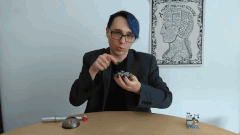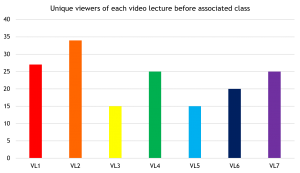This article has been divided into two parts. Part 1 is about the Production process and Part 2 discusses Student engagement, feedback, and reflections.
In the summer of 2018, I challenged myself to produce video “preludes” to create a partially flipped classroom for an Organic Chemistry module. This second blog entry covers how the videos were used in the course, student viewing figures and feedback, and where the project might lead in the future.
 The first video had been released to the students. In the next lecture, I made use of Poll Everywhere to ask three questions regarding its content: two were related to the chemistry discussed, one was observational – an attempt to see how many students had watched! Most of the students didn’t get the Chemistry questions correct, though surprisingly most of them knew the answer to the observational question (perhaps this was because it was an easy reference to the film ‘Back to the Future’). Most subsequent lectures began like this, followed by a short recap on the content of each video.
The first video had been released to the students. In the next lecture, I made use of Poll Everywhere to ask three questions regarding its content: two were related to the chemistry discussed, one was observational – an attempt to see how many students had watched! Most of the students didn’t get the Chemistry questions correct, though surprisingly most of them knew the answer to the observational question (perhaps this was because it was an easy reference to the film ‘Back to the Future’). Most subsequent lectures began like this, followed by a short recap on the content of each video.
 In terms of meeting my aims of including more opportunities for class discussion and active learning, the video prelude lectures made this much more possible. In particular, the majority of a two-hour session (lecture 9) was dedicated to a Team-Based Learning activity, giving students the chance to practice applying their knowledge of some more tricky aspects of the module.
In terms of meeting my aims of including more opportunities for class discussion and active learning, the video prelude lectures made this much more possible. In particular, the majority of a two-hour session (lecture 9) was dedicated to a Team-Based Learning activity, giving students the chance to practice applying their knowledge of some more tricky aspects of the module.
 What were the viewing figures like? I should note that students were also given the necessary information in the lecture handouts (available beforehand on KEATS), so they could learn the material this way – but my assumption was a short video was preferable to reading! Using KEATS logs and an analytics programme, I looked into unique views of each video before the lecture. The average across the module was 23 – only about a quarter of the class. Even taking into account persistent non-attendees, and some students watching the videos together, this was a slightly disappointing number.
What were the viewing figures like? I should note that students were also given the necessary information in the lecture handouts (available beforehand on KEATS), so they could learn the material this way – but my assumption was a short video was preferable to reading! Using KEATS logs and an analytics programme, I looked into unique views of each video before the lecture. The average across the module was 23 – only about a quarter of the class. Even taking into account persistent non-attendees, and some students watching the videos together, this was a slightly disappointing number.
However, from those students who did make use of the videos, the feedback was generally positive. One commented that the videos were “great for the little introduction required to understand [the] background to what is going on in the lecture.” So there was definitely a positive impact in that it helped some students come to the lectures feeling more prepared.
Looking at the bigger picture, there was significant positive feedback for the class activities that taking the basics out of the classroom had made room for. Whilst then perhaps some students didn’t feel a need to revise their A-Level material, they found a benefit in spending longer on the more advanced areas.
 So where to next? I intend to use the videos again next academic year, with the addition of another to accompany lecture 10 – this will help to better illustrate some of its fundamental concepts. To increase student viewing, I think more explanation of why the videos exist will be helpful, along with reminders via KEATS to watch, and limiting the amount of recap of the content to increase student responsibility for coming to class prepared. Most of all though, I hope to inspire other educators to give this approach a go, and I would be interested to learn about their results!
So where to next? I intend to use the videos again next academic year, with the addition of another to accompany lecture 10 – this will help to better illustrate some of its fundamental concepts. To increase student viewing, I think more explanation of why the videos exist will be helpful, along with reminders via KEATS to watch, and limiting the amount of recap of the content to increase student responsibility for coming to class prepared. Most of all though, I hope to inspire other educators to give this approach a go, and I would be interested to learn about their results!
Useful links
- [Crash Course] Youtube channel
- [The Teacher] a useful resource for learning advance PowerPoint animation techniques
- [Audacity] free audio editing software
- [Shotcut] free video editing software
- [PowerPoint 2016 Animations] enliven your presentations by animating text and graphics
Written by Dr Daniel Cornwell
 Dan Cornwell joined King’s College in 2016 as a Teaching Fellow in the Department of Chemistry, and has recently accepted the position of Lecturer in Chemistry Education. As well as delivering lectures, workshops and labs across undergraduate year groups, they work on designing, developing and implementing innovative methods to support the teaching of Chemistry. Their pedagogic research interests include technology-enhanced learning, Team-Based Learning methodologies, and the types of language used to explain complex scientific ideas.
Dan Cornwell joined King’s College in 2016 as a Teaching Fellow in the Department of Chemistry, and has recently accepted the position of Lecturer in Chemistry Education. As well as delivering lectures, workshops and labs across undergraduate year groups, they work on designing, developing and implementing innovative methods to support the teaching of Chemistry. Their pedagogic research interests include technology-enhanced learning, Team-Based Learning methodologies, and the types of language used to explain complex scientific ideas.
